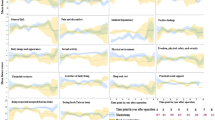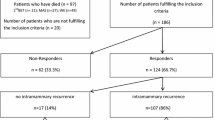Abstract
This paper reports the quality of life (QoL) of a large cohort of Australian women three and twelve months after surgery for early stage breast cancer (ESBC), and shows that the impact of disease and treatment on QoL differed by age, education and marital status. Eighty-three percent of eligible patients were recruited; 86% had breast conserving surgery and 14% mastectomy. Response rates were 93% (n = 305) at three months and 88% (n = 291) at one year. Quality of life was measured with the EORTC core questionnaire (QLQ-C30) and an ESBC-specific questionnaire. Multilevel analysis was used to estimate the effects and interactions of time, treatment and patient characteristics. Most symptoms declined between three months and one year, but arm and menopausal symptoms persisted. Emotional, social and role functioning improved over time, and fear of disease recurrence diminished. Younger women faired worse than older women on a broad range of QoL dimensions. Single women and those with less education faired worse on a number of dimensions. The negative impact of mastectomy on body image was greatest among married women, particularly young married women. These sociodemographic distinctions are relevant when discussing treatment options with women facing a diagnosis of ESBC.
Similar content being viewed by others
References
Early Breast Cancer Trialists' Collaborative Group. Effects of radiotherapy and surgery in early breast cancer: An overview of randomised trials. N Engl J Med 1995; 333: 1444–1455.
Moyer A. Psychological Outcomes of Breast-Conserving Surgery Versus Mastectomy: A Meta-analytic review. Health Psychology 1997; 16: 284–298.
National Health and Medical Research Council. The Management of Early Breast Cancer: Clinical Practice Guidelines. Canberra: Australian Government Publishing Service, 1995.
Aaronson NK, Ahmedzai S, Bergman B, et al. The European Organization for Research and Treatment of Cancer QLQ-C30: a quality-of-life instrument for use in international clinical trials in oncology. J Natl Cancer Inst 1993; 85: 365–376.
Zigmond AS, Snaith RP. The Hospital Anxiety and Depression Scale. Acta Psychiatr Scand 1983; 67: 361–370.
Wellisch DK, DiMatteo R, Silverstein M, Landsverk J, Hoffman R, Waisman J, Handel N, Waisman-Smith E, Schain W. Psychosocial outcomes of breast cancer therapies: lumpectomy versus mastectomy. Psychosomatics 1989; 30: 365–373.
Aaronson NK, Cull A, Kaasa S, Sprangers MAG, EORTC Study Group on Quality of Life. The European Organisation for Research and Treatment of Cancer (EORTC) Modular Approach to Quality of Life Assessment in Oncology: An Update. In: Spilker B (ed) Quality of Life and Pharmacoeconomics in Clinical Trials, Philadelphia: Lippincott-Raven Publishers, 1996; 179–189.
Kenny P, King M, Shiell A, Seymour J, Boyages J, Hall J. Early Stage Breast Cancer - Quality of Life Three Months and One Year after First Treatment. CHERE Discussion Paper Series No. 42. Sydney, Centre for Health Economics Research and Evaluation, 2000.
Fayers P, Aaronson N, Bjordal K, Sullivan M. EORTC QLQ-C30 Scoring Manual. Brussels: EORTC Study Group on Quality of Life, 1995.
Fairclough DL, Cella DF. Functional Assessment of Cancer Therapy (FACT-G): non-response to individual questions. Quality of Life Res 1996; 5: 321–329.
Cohen J. Statistical Power Analysis for the Behavioural Sciences. Hillsdale, NJ: Lawrence Erlbaum Associates, 1988.
King MT. The interpretation of scores from the EORTC quality of life questionnaire QLQ-C30. Quality of Life Res 1996; 5: 555–567.
Goldstein H. Multilevel Statistical Models. 2nd edn. London: Arnold, 1995.
Armitage P, Berry G. Statistical Methods in Medical Re-search. Oxford: Blackwell Scientific Publications, 1994.
Hochberg Y. A sharper Bonferroni procedure for multiple tests of significance. Biometrika 1988; 75: 800–802.
Goldstein H, Rasbash J, Plewis I, et al. A User's Guide to MlwiN. London: Multilevel Models Project, University of London, 1998.
SAS Institute Inc. SAS/STAT User's Guide, Version 6. 4th edn., Vols 1 & 2. Cary, NC: SAS Institute Inc, 1989.
Hjermstad MJ, Fayers PM, Bjordal K, et al. Health-related quality of life in the general Norwegian population assessed by the European Organization for Research and Treatment of Cancer Core Quality-of-Life Questionnaire: the QLQ = C30 (+3). J Clin Oncol 1998; 16: 1188–1196.
Hjermstad MJ, Fayers PM, Bjordal K, et al. Using reference data on quality of life - the importance of adjusting for age and gender, exemplified by the EORTC QLQ-C30 (+3). Eur J Cancer 1998; 34: 1381–1389.
Klee M, Groenvold M, Machin D. Quality of life of Danish women: population-based norms of the EORTC QLQ-C30. Quality of Life Res 1997; 6: 27–34.
Ganz PA, Schag CA, Lee JJ, Polinsky ML, Tan S. Breast Conservation versus mastectomy: Is there a difference in psychological adjustment or quality of life in the year after surgery. Cancer 1992; 69: 1729–1738.
Schag CA, Ganz PA, Polinsky ML, Fred C, Hirji K, Petersen L. Characteristics of women at risk for psychosocial distress in the year after breast cancer. J Clin Oncol 1993; 11: 783–793.
Curran D, van Dongen JP, Aaronson NK, et al. Quality of life of early-stage breast cancer patients treated with radical mastectomy or breast-conserving procedures: Results of EORTC trial 10801. Eur J Cancer 1998; 34: 307–314.
Kemeny MM, Wellisch DK, Schain WS. Psychosocial outcome in a randomised surgical trial for treatment of primary breast cancer. Cancer 1988; 62: 1231–1237.
Schover LR, Randall JY, Laurie JT, et al. Partial mastectomy and breast reconstruction: a comparison of their effects on psychosocial adjustment, body image and sexu-ality. Cancer 1995; 75: 54–64.
Street RL, Voigt B. Patient participation in deciding breast cancer treatment and subsequent quality of life. Med Decis Making 1997; 17: 298–306.
Kenny P, Quine S, Shiell A, Cameron S. Participation in treatment decision making by women with early stage breast cancer: a qualitative approach. Report to the New South Wales Cancer Council. Centre for Health Economics Research and Evaluation Project Report No 5: Sydney, 1997.
Kissane DW, Clarke DM, Ikin J, et al. Psychological morbidity and quality of life in Australian women with early-stage breast cancer: a cross-sectional survey. MJA 1998; 169: 192–196.
Pocock SJ, Geller NL, Tsiatis AA. The analysis of multiple endpoints in clinical trials. Biometrics 1987; 43: 487–498.
Author information
Authors and Affiliations
Rights and permissions
About this article
Cite this article
King, M.T., Kenny, P., Shiell, A. et al. Quality of life three months and one year after first treatment for early stage breast cancer: Influence of treatment and patient characteristics. Qual Life Res 9, 789–800 (2000). https://doi.org/10.1023/A:1008936830764
Issue Date:
DOI: https://doi.org/10.1023/A:1008936830764




